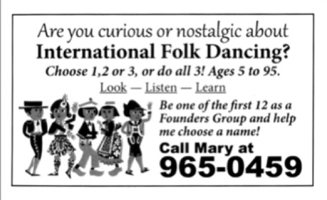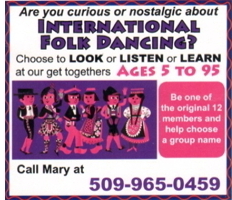
|
The Society of Folk Dance Historians (SFDH)
Reviving Folk Dance
[
Home |
About |
Encyclopedia | CLICK AN IMAGE TO ENLARGE |

|
This is an account of a successful advertising campaign, from issues of the 2013 Report to Members.
We honor Mary Stensrud (Yakima, Washington), because Mary started and maintained folk dance groups in Yakima for decades in the face of overwhelming apathy and even some active resistance. Mary, at age 95, moved to a new home and printed up these business cards and ads to find 12 people interested in starting yet another group.
Mary printed to advertise a new International Folk Dance (IFD) group in Yakima. She printed up these placards . . . and it worked! The first meeting of the Yakima Folk Dancers had 15 people who "seemed to have a good time." Now Mary may be indefatigable, but that's no reason for you not to do likewise, if your town lacks a group.
Mary carried the cards with her, and she posted these signs in laundromats, grocery stores, and other public places around her neighborhood. She did not get 12 people, she got 15! Homeschoolers, curious adults, and former dancers all came for several weeks and probably would have continued to come, except that Mary was one of those blessed people who never run out of interesting anecdotes. The people didn't want to hear her; they wanted to hear the music and to dance. After several weeks, they stopped coming. I think Mary also erred in using the old RCA recordings by Michael Herman, that catered more to physical education classes of the 1950s, rather than to the dynamic and fascinating music that we have today. Take heed.
COMMENTS
Here are some of the postings from the East European Folklife Center (EEFC) list in October 2018, about declining membership. Might be some good ideas here. Check the EEFC list for the original messages and authors.
Our group in Winnipeg, Manitoba is also aging, and our membership peaked a few years ago and has declined slightly, but we also have younger members who have joined over the past 10 years or so, not quite off-setting others who have left the group. Most of our growth comes from word of mouth, open houses, and our interconnections with the recreational dance community, such as English, contra, and square dancers. This fall, as an experiment, we created a Meetup group and this has generated a number of people coming out to give it a try, ranging in age from their 20s to 40s. Most don't stick with it, but a few seem like they will be regulars. Sometimes we get a small group of friends coming out together, and even if they don't return it's fun to have them. There is a cost to maintaining a Meetup group ($15 per month), but so far it seems like a more effective form of advertising than others we have tried.
I am glad to hear that the Massachusetts Institute of Technology (MIT) club is not the only IFD group left in the Boston area. We are not alone in having trouble getting younger blood, but we think we do some things better than other groups. To avoid hanging out with gray-haired folk, maybe the young will start their own clubs? If that is the case, then maybe the groups need to adapt to the older clients?
Both of our Triangle area groups went through a similar phase in losing university, or near university spaces about 30 years ago due to a lack of student involvement.
The Raleigh IFD group set up an affiliation with the city's Parks & Recreation department, with the understanding that there would be a solid teaching program, run by two unpaid "staff," that the group is always open to all new-comers, and that we keep a sign in attendance system. The group is listed among the programs offered through Parks and Recreation. We pay a modest rent for the Glen Eden Pilot Park building. With this system, we do get more new people coming in, but we are very dependent on our dedicated teaching "staff." Some of the groups having problems may look into a similar system. The Friday night group meets from 6:30 to 10:00 p.m. (50 to 52 weeks every year).
Our Chapel Hill, North Carolina IFD group (Wednesday) has not met inside the city for about 25 years, but meets in rented spaces in Durham. The real estate/rent, including for a dance space in nearby Carrboro Century center is too high for our size but we had been able to rent a synagogue's social hall until they recently displaced us temporarily to build a new worship hall. The group now is part of a Durham downtown dance arts group, The Living Arts Collective. We have some other folk dance groups, like the Triangle Country Dancers, which is a very large group, with live music that uses rented spaces in Carrboro and Durham on Friday and Saturday nights.
Our dancers are a wide range of ages, from 10 to 95, but we don't attract the college crowds, and there has been more graying of our most dedicated teachers. We have raised a few music and dance enthusiasts, and many of these eventually leave and go where their jobs, and passions, take them. Almost all of the experienced dancers take turns teaching, so young people are exposed to different teachers. The college age is a special problem we have discussed for several years.
Sometimes, it is time to recognize that some of the boomer drivers are now too elderly to do the hard stuff, but our groups clearly show that one ages in better condition by dancing. Over the past 10 years, we have our local premium retirement community, Carol Woods, which has two floating dance floors, become a place for IFD dancers to retire. We have several dancers there already. Teachers are now holding free spring/fall 6-week beginner sessions Monday nights at Carol Woods, guests permitted in after signing an insurance waiver every time. In our area, you could find dancing almost every night, and during some parts of the year, you can do IFD three nights a week, two nights for the rest of the year.
I wish you all well in keeping IFD dancing alive.
If it's any consolation, I can tell you that when MIT's Tuesday night "advanced/Balkan" session petered out some years ago, it was, in fact, revived – no longer on Tuesday, no longer at MIT, but now as a monthly dance called Tuesday Night Revival – and is going strong (see https://tuesdaynightrevival.com/ for more info, including program listings.) This session is coordinated by Ira Gessel, but he is probably too modest to mention that fact, though we participants are perpetually grateful. (Ira also maintains the MIT MIT Folk Dance Club Songbook, frequently mentioned as a source of IFD song lyrics – but he is probably too modest to mention that, either!)
Boston is also lucky enough to have two nights of international dancing each week run by the Folk Arts Center of New England (FAC), plus an additional night in nearby Framingham, and monthly events on most Saturdays. In fact, when trying to schedule a special event, it's pretty hard to find a "free" Saturday night.
Not that there are not issues, and we periodically have discussions about how to get more younger people involved (though thanks largely to the efforts of Andrea Taylor-Blenis, we have an (apparently) unusually large contingent of younger dancers that includes both second generation dancers and others. Steve and Susy Kotansky remarked how our average age was much lower than other camps they have seen.
The Folk Arts Center maintains a calendar "Folk Dancing 'Round Boston" where you can find lots of info.
It is sad and frustrating to experience this continuing decline. Thank you, EEFC, for your two camps which foster the participation of children and teens, who in so many cases are becoming our leaders.
DOCUMENTS
- Attracting and Retaining New Folk Dancers, an article.
- Attracting New Dancers, an article.
- Chronology of International Folk Dancing, an article.
- Folk Dance Decline and Resurrection, an article.
- Folk Dance Demise, an article.
- Folk Dance Revival, an article.
- IFDC Challenges Declining Numbers, an article.
- Let's Bring Folks Back to Recreational Folk Dancing, an article.
- Reviving Folk Dance, an article.
- Revitalization Committee Report, an article.
- Ron Houston, an article.
- Three Kinds of Teachers: Which Shall We Follow?, an article.
- We Need a Commercial!, an article.
- Where Have All the Children Gone?, an article.
This page © 2018 by Ron Houston.
Please do not copy any part of this page without including this copyright notice.
Please do not copy small portions out of context.
Please do not copy large portions without permission from Ron Houston.

